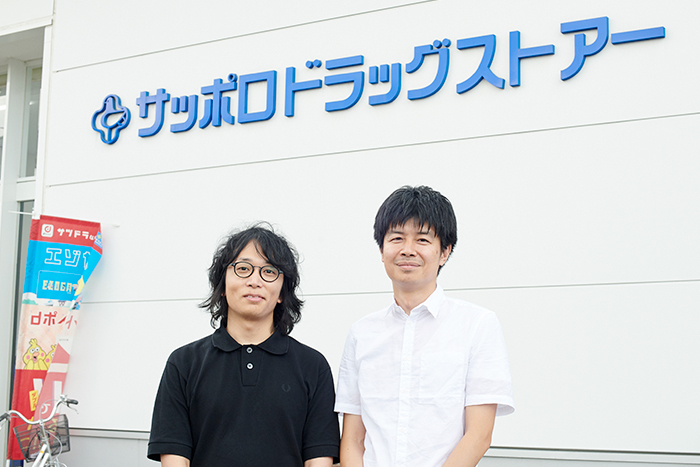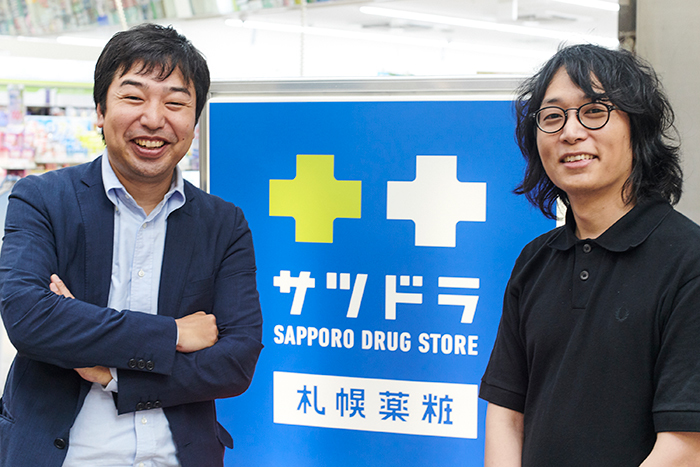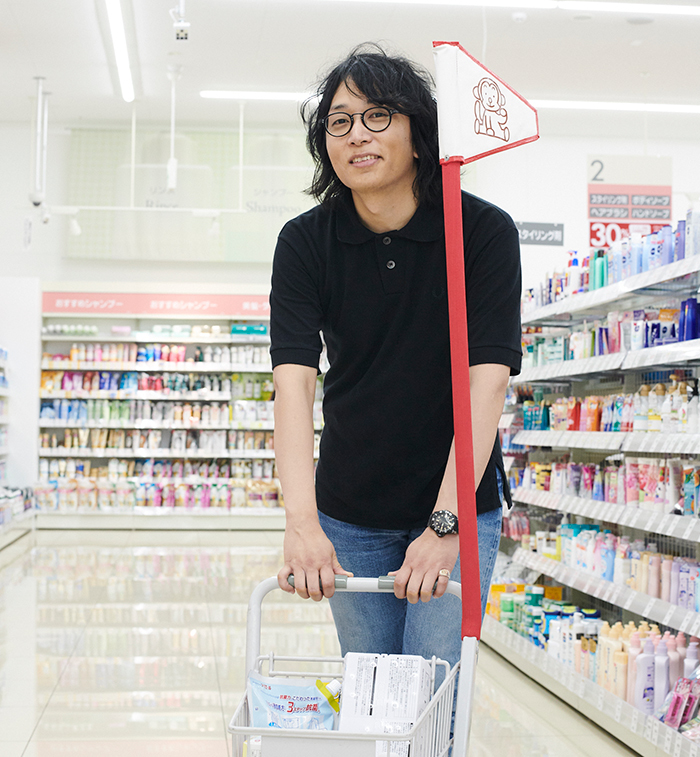This is a project where Dentsu Inc. communication planners active on the front lines report on "currently intriguing locations or spots" that have caught their attention.
The Front Lines of "Next-Generation Retail" Advancing in the Northern Land
The Sapporo Drug Store visited by planner Chu Hichol is affectionately known as "Satsudora." It is Hokkaido's second-largest drugstore chain, operating approximately 200 stores within the prefecture (plus 11 stores outside Hokkaido and 5 overseas). Founded in 1972. It is actively collaborating with partner manufacturers to pioneer new forms of digital marketing, such as analyzing customer behavior with AI cameras and implementing store-linked O2O initiatives. The company is also aggressive in its AI adoption efforts, applying insights gained from solving regional and retail challenges both domestically and internationally.
Points that caught Zhu's attention
When working on digital × retail, you inevitably hear the name "Satsudora" cited as an example. While well-known within the industry, it also has a mysterious side: pursuing a unique strategy of development by committing to Hokkaido, even as other drugstore chains expand through M&A. With its cutting-edge insights and independent approach, I definitely wanted to visit the region to see the reality for myself.
Interview with Emi Sugiyama, Incubation Team Leader at Satsudora Holdings!

(From left) Mr. Zhu Xizhe, Ms. Emi Sugiyama (Satsudora Holdings)
[Q1]
Please explain in detail the objectives and methods behind installing AI cameras in stores.
We aim to "webify" and "medialize" physical stores through AI camera utilization. "Webification" means capturing user behavior and conversion rates as data, similar to the online world. "Medialization" involves using that data to understand the influence of specific sections or shelves and identify target demographics, enabling us to assign value to each store component.
For about a year now, we've been conducting trials at our experimental store, "Satsudora Tsukisamu Nishi 1-jo Store" in Sapporo. Over 90 AI cameras are installed throughout the store, enabling us to collect data on each customer's gender, age group, and in-store behavior. Naturally, measures are in place to ensure no individuals are identifiable. This allows us to understand various details: what kind of customers visit, what routes they take through the store, which shelves they look at, which products they compare, and how long they spend deliberating.
Currently, about 50 of the in-store AI cameras were installed independently, while the remaining 40 or so were requested by manufacturers of products sold in the store. They are positioned to capture deeper data, incorporating manufacturer-specific perspectives such as the percentage of customers interested in new products or the correlation between tester usage and purchased items.
【Q2】
What insights have you gained from installing AI cameras?
Please also share your future outlook.
We've uncovered surprising data that overturns conventional wisdom. For instance, POS register data previously indicated that about 70% of customers were female and 30% male, but we discovered the actual ratio is nearly equal. This indicates a significant number of male customers not captured by point card data. We also uncovered real-world behaviors, such as men purchasing beer during their commute home. Furthermore, we discovered critical areas for improvement: a large number of customers followed paths completely different from the carefully designed route from the entrance to the register, and even within similar sales areas, certain products had distinct selling characteristics.
As analysis progresses and the cost-effectiveness becomes clearer, I imagine we can actively pursue major changes like product mix adjustments and store layout modifications. Furthermore, once various solutions are established from this, I hope we can expand our business to apply these insights to other industries.
The metrics and concepts are precisely what e-commerce pursues. That's why I strongly felt the synergy between digital and physical insights.
Interview with Tsuyoshi Yamamoto, Digital Marketing Promotion Manager, Merchandising Department, Sapporo Drugstore!

(From left) Mr. Tsuyoshi Yamamoto (Sapporo Drug Store), Mr. Zhu Xizhe
[Q1]
Your "store-linked O2O initiatives" developed in collaboration with manufacturers are also generating buzz.
What kind of initiatives are these?
Specifically, the main focus is on distributing YouTube ads designed to drive store visits. Unlike TV commercials, these ads can be targeted to specific geographic areas, making them well-suited for locally rooted retailers. In our case, we are currently distributing these ads while adjusting the targeting intensity for each area.
Another key feature is that we produce these ad videos ourselves. We believe creating them from the "sales floor perspective" allows us to craft content that truly resonates with customers who frequent each store daily. Actually, I sometimes draw the storyboards myself (laugh).
Furthermore, we promote the products featured in the ad videos in our physical stores in a coordinated manner. This is why it can be called an "in-store linked O2O initiative." The system that measures whether users who watched the YouTube video actually visited the store enhances the value of this initiative. We also utilize POS register data to analyze how many people who saw the YouTube ad visited the store and made a purchase, using this insight for our next initiatives.
【Q2】
Please share the challenges and results of consistently maintaining the "sales floor perspective" and "local focus."
As this was a new challenge, convincing manufacturers was tough initially. Back then, we couldn't visualize the value YouTube brought. To secure cooperation, we insisted on pairing it with "properly building the sales floor." Many manufacturers actually shared the frustration: "Customers know our brand from TV commercials, but the crucial in-store display isn't catching their eye." This commitment to designing "advertising and the store" as a unified set became key to realizing this initiative.
Our strength as a community-focused retailer lies in understanding "what customers truly want" through daily interactions at the store. While a manufacturer's product targeting might be correct on a national scale, it can be inappropriate for a local chain. We can make such adjustments. Overlaying our locally relevant messaging onto manufacturer-driven mass advertising deepens customers' understanding of the products.
Our ability to conduct numerous small-scale experiments, including AI camera initiatives, is also a direct result of our local roots. We are deeply grateful that an increasing number of manufacturers now consider us their go-to partner for launching new products or promotions. We look forward to continuing these customer-focused experiments in collaboration with manufacturers.
I had no idea you handled everything from production to operations! I'll keep in mind that those who truly know the customer are best positioned to design effective strategies.
Satsudora's "Inbound Specialty Store"
One of Hokkaido's defining features is its abundance of visitors from Asia and other parts of the world, drawn by its rich nature, delicious food, and leisure facilities like ski resorts. Sapporo Drug Store has focused on creating "inbound specialty stores" with store designs and product selections tailored for foreign visitors. As a result, they now have stores overseas as well.
Finally... (by Zhu)
I'd only heard rumors about Satsudora. The reality revealed a professional group with cutting-edge expertise, backed by their hard work—from producing video materials (uncommon for retailers) to media management. Their grand design impressed me: accumulating know-how gained through "experiments" involving numerous manufacturers, then offering consulting services to non-competing peers outside Hokkaido—precisely because they don't fully expand beyond the prefecture. Above all, it was their deep-rooted local presence and the trust built with customers that allowed them to nurture the seeds of their next data business.











